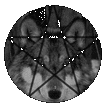A Sabbat is a Wiccan Holiday or Festival. The word "sabbat" is derived from a Hebrew word which means to rest. Unlike human-made holidays the Sabbats are naturally occurring events. Sabbats follow the path or progress of the sun though its annual and seasonal changes, whereas Esbats are an observance and celebration of the moon. (Esbats can be observed at any phase of the moon, however traditionally they are observed on each full moon. There are 12 to 13 full moons each year.)
The Sabbats consist of the four solar quarter-points on The Wheel of The Year as well as the cross-quarter points (inbetween each quarter), making a total of eight in all. The solar quarter-points on the wheel are the 2 Equinoxes (one in the Spring and one in the Fall), when day and night are of equal length, as well as the two Solstices; the longest day of the year ( in Summer) and the longest night of the year (in Winter).
The Sabbats which are considered the Greater or Major Sabbats are the four cross-quarter dates, also known as Earth Holidays. They are; Samhain (circa Oct. 31st.), Imbolc (circa Feb. 2nd.), Beltane (circa May 1st.), and Lammas (also called Lughnassad, circa Aug. 2nd.). The Sabbats which are consisdered the Lesser or Minor Sabbats are the four quarter dates also known as the Sun or Fire Festivals. On a secular calendar, these would be the dates when each new season offically begins. They are; the Winter Solstice (Yule, circa Dec. 21st.)), the Vernal Equinox (Ostara, circa Mar. 21st.), the Summer Soltice (Midsummer or Litha, circa June 21st), and the Autumnal Equinox (Mabon, circa Sept. 21st).
There are actually two sets of dates for every Sabbat in each calendar year. There are the traditional dates, which remain the same as well as the actual astrological quarter and cross-quarter dates which vary slightly from year to year. The dates I have given above are the traditional dates. If you wish to know the actual astrological dates for any given year I recommend purchasing a wiccan calendar each year such as Llewellyn's Witches' Datebook or The Witches' Almanac published by Newport. The Witches' Almanac is organized in the astological calendar rather than a traditional Roman Calendar but does give the traditional Roman Calendar dates, whereas the Llewellyns' datebook follows the Roman Calendar while also providing the astrological dates.
The Wheel keeps on turning, the cycles of life keep repeating.
We, who practice Wicca, look to nature to teach us of deeper spirituality, and to guide us in this earthly life.
The Goddess and God have many faces, yet they are one.
As the seasons change, different aspects of the Deities are revealed. Different cycles of life are taught, and we learn wisdom by their study.
The Wheel begins with Samhain (pronounced "sow-en"), or "The Witch's New Year". We mourn the "death" of the Sun God. In its cold decaying state, the earth also appears to be dying. Yet out of this apparent death new life will eventually spring forth. We learn that death is a part of life. While the earth lies dormant, the hidden forces are at work. Through Yule we celebrate the fact that the Sun will be re-born of the Goddess/Earth, and that the cold and deathlike winter cannot hold Him. The wheel will turn. Through Imbolc, Ostara, and Beltane we see the ground warming and bringing forth new life. All things renew themselves. At Mid-Summer, fertility is at its peak, full and ripe with fulfillment. Then the wheel turns to the harvests of Lammas, Mabon, and finaly once again to Samhain. As the wheel continues to repeat its cycles, we find that the lessons each Sabbat teaches continually yeild deeper meanings for our lives. |






